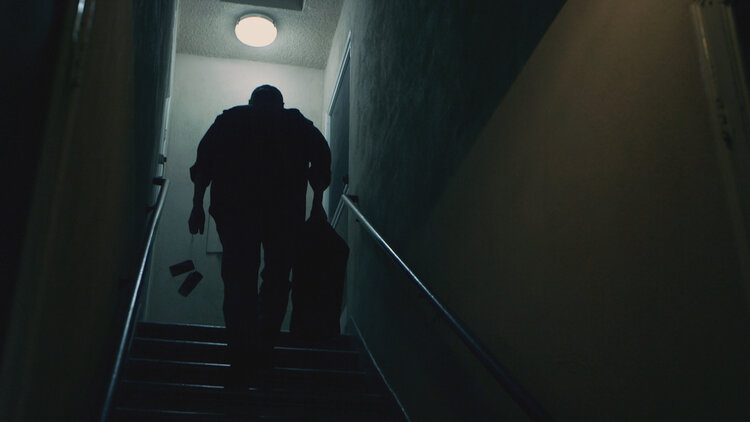‘The Penny Black’ immerses viewers into moody film noir - The Park Record
Will Cassayd-Smith, subject of The Penny Black
“The Penny Black” is a film noir filled with a million-dollar stamp collection that may or may not be stolen, a neighbor with a blurry past and a possible, but elusive tie to the Armenian Mafia.The film, named after the first adhesive postage stamp, will screen at 5:15 p.m. on Tuesday at Slamdance, is also a documentary in the film festival’s breakout category.It follows the plight of Will Smith, a young publicist who lives in L.A. One day, his neighbor, an imposing man from Russia, asks Smith if he could take care of a bag full of rare stamps for a couple of weeks.
Saunders, who met Smith through the film’s producer Alexander Greer, decided it would be fun to make a short film about some of the “crazy things that happen in L.A.” “It was just going to be a short slice-of-life documentary,” Saunders said. But after two weeks, the Russian, who lived in the next apartment from Smith, just disappeared. That was when Smith began examining the stamps.
Joe Saunders and Alex Greer prep the PI during filming of The Penny Black
“When we started researching and tallying things up, we began to realize very quickly things add up if you have a $36,000 stamp and then one that’s $60,000 and one that’s $25,000,” Saunders said.
That’s when Smith’s story got exciting, the filmmakers said.
“One of the elements of the story is who the strange Russian guy is, and whether or not we should be afraid,” Saunders said. “The more expensive the stamps became, the bigger threat he became, because we didn’t know what had happened to him. We didn’t know if he was coming back or if someone else was going to track Will down.”
That sense of danger is what Saunders and Greer wanted to convey through the film.
“Joe and I, in our filmmaking approach, are generally drawn to things that are interesting and a little extreme,” Greer said.
There are scenes of stakeouts and one of an uneasy meeting in a local bar, where Greer had to pretend he was a patron who was watching sports on the TV.
“I had a walkie talkie with a com in my ear, and I had to put my hood up to cover it,” he said. “I also had Joe’s iPhone so I could get some reverse (angle) shots, while Joe was in a car across the street shooting footage with a long lens.”
The two did hire a bodyguard to protect Smith and themselves during the bar scene.
“The bodyguard sat in another corner of the bar with another one of our friends, so he wouldn’t stick out,” Saunders said. “We did that just in case so we could feel a little more at ease.”
One of the things Saunders wanted to capture in “The Penny Black” was how the mystery unfolded,as Smith and they experienced it.
“That’s the only way we were able to tell the story,” Saunders said. “We wanted to recreate our own experience on this journey.”
The scenario became more complicated when Smith, while doing research on the bag of stamps, comes across a woman, Bonnie Collins, who claimed a large collection of expensive and rare stamps were stolen from her family.
Smith, doing his due diligence, decided to travel to Arizona to visit Collins, who claimed to have grown up with Freemasons and the Ku Klux Klan.
“Bonnie was very open and warm, but like a Bond villain before they open the (trap door),” Saunders said. “This could have been their stamp collection, but who knows, because there was no proof tying them to her.”
Through all the craziness and sense of danger, the filmmakers never thought to stop filming.
Early in the project, the filmmakers drafted up a document for production insurance.
“It laid out all the possible scenarios that could potentially happen that would cause injury or if someone tracked us down and stabbed us,” Greer said. “We called it ‘the document that our mothers could never see.’”
Greer’s father even voiced his concern.
“He sat me down and said, ‘Can you please stop doing this movie?’” Greer said. “We realized then if we were making something that terrified our parents, then we were onto something good.”
Saunders said the only time filming would have stopped is if Smith refused to do any more shooting.
“He kept going, even reluctantly sometimes,” Saunders said. “But it was all his decision.”
Adding to the documentary’s aura is the soundtrack by Drum & Lace, a musical project helmed by Sophia Hultquist.
“What attracted me to her music is that it has a dark and foreboding but also has a spacious landscape to it,” Greer said. “It carries a huge emotional weight, and it felt strongly suited to tell a story in this environment that is wayward and confusing.”
Saunders originally cut the film with music that fit a classic, film noir style.
“I decided against using it, because while the film is a mystery and we wanted to play with the noirish style, we didn’t want to hit it on the head,” he said. “We wanted to have something more modern with the score to accentuate the emotion, but keep away from the classic film noir sound.”
The music was the only thing that really went as planned with the film, Greer said.
“Every time we would plan to shoot a scene, we would sketch out what we wanted to do, but every time we went to shoot, something would always happen that wasn’t remotely near the list we had drawn up,” he said. “By the time we were near the end, we expected a curveball slider, and we got it.”


